一、数据格式
1.1 dicom
- DICOM是医学图像中的标准文件,这些文件包含了诸多元数据信息(比如像素尺寸),此处以
kaggle Data Science Bowl数据集为例:data-science-bowl-2017,数据列表如下:
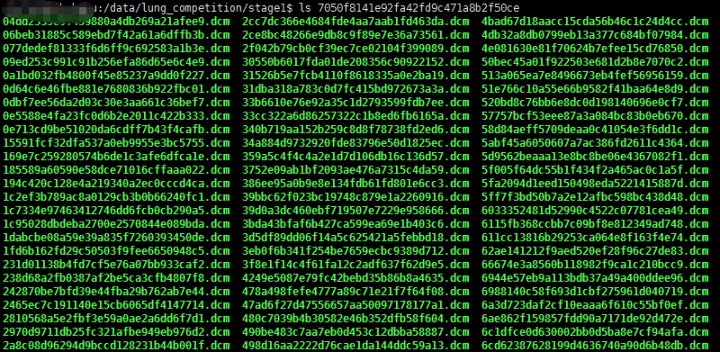
- 后缀为 .dcm。
- 每个病人的一次扫描CT(scan)可能有几十到一百多个dcm数据文件(slices)。可以使用 python的
dicom包读取,读取示例代码如下:dicom.read_file('/data/lung_competition/stage1/7050f8141e92fa42fd9c471a8b2f50ce/498d16aa2222d76cae1da144ddc59a13.dcm')
- 其
pixl_array包含了真实数据。slices = [dicom.read_file(os.path.join(folder_name,filename)) for filename in os.listdir(folder_name)]
slices = np.stack([s.pixel_array for s in slices])1.2 mhd格式
- mhd格式是另外一种数据格式,来源于(LUNA2016)[https://luna16.grand-challenge.org/data/]。每个病人一个mhd文件和一个同名的raw文件。如下:
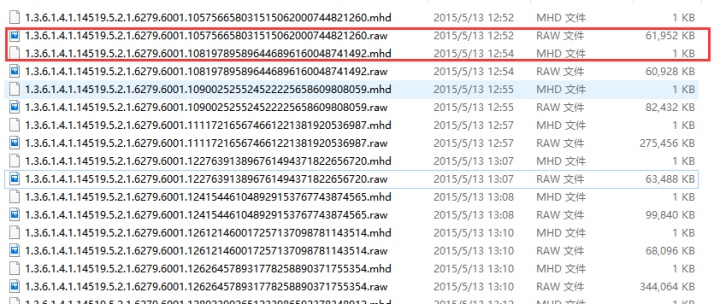
- 一个raw通常有几百兆,对应的mhd文件只有1kb。mhd文件需要借助python的SimpleITK包来处理。SimpleITK 示例代码如下:
import SimpleITK as sitk
itk_img = sitk.ReadImage(img_file)
img_array = sitk.GetArrayFromImage(itk_img) # indexes are z,y,x (notice the ordering)
num_z, height, width = img_array.shape #heightXwidth constitute the transverse plane
origin = np.array(itk_img.GetOrigin()) # x,y,z Origin in world coordinates (mm)
spacing = np.array(itk_img.GetSpacing()) # spacing of voxels in world coor. (mm) - 需要注意的是,SimpleITK的
img_array的数组不是直接的像素值,而是相对于CT扫描中原点位置的差值,需要做进一步转换。
1.3 查看CT扫描文件软件
- 一个开源免费的查看软件 mango
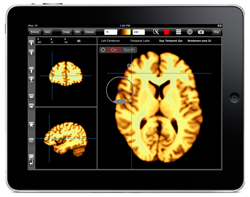
二 dicom格式数据处理过程
2.1 处理思路
- 首先,需要明白的是医学扫描图像其实是三维图像,使用代码读取之后查看不同的切面的切片(slices),可以从不同轴切割。
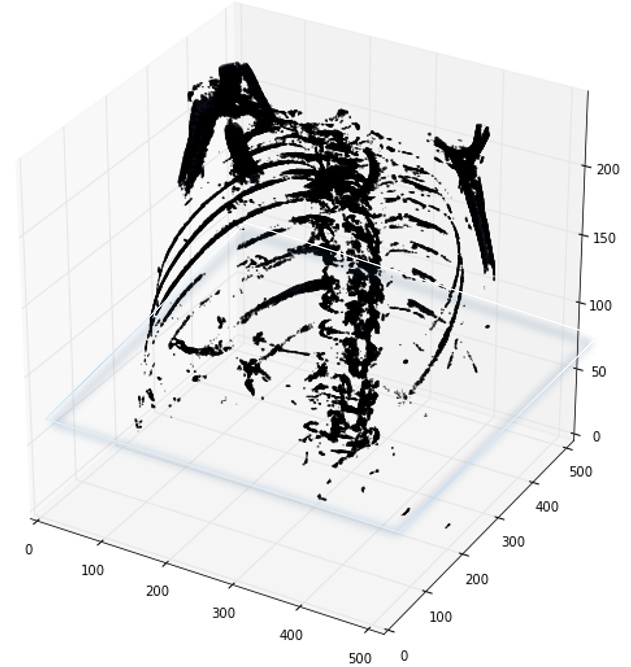
- 如下图展示了一个病人CT扫描中,其中部分切片slices:
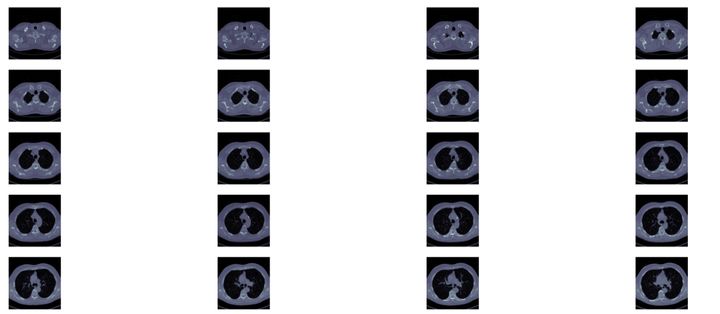
- 其次,CT扫描图是包含了所有组织的,如果直接去看,看不到任何有用的信息,需要做一些预处理,预处理中一个重要概念是仿射剂量,衡量单位为
HU(Hounsfield Unit),下表是不同放射剂量对应的组织器官:

Hounsfield Unit = pixel_value * rescale_slope + rescale_intercept
- 一般情况rescale slope = 1, intercept = -1024。
- 上表中肺部组织的HU数值为-500,但通常是大于这个值,比如-320、-400。挑选出这些区域,然后做其他变换抽取出肺部像素点。
2.2 先载入必要的包
# -*- coding:utf-8 -*-
'''
this script is used for basic process of lung 2017 in Data Science Bowl
'''
import glob
import os
import pandas as pd
import SimpleITK as sitk
import numpy as np # linear algebra
import pandas as pd # data processing, CSV file I/O (e.g. pd.read_csv)
import skimage, os
from skimage.morphology import ball, disk, dilation, binary_erosion, remove_small_objects, erosion, closing, reconstruction, binary_closing
from skimage.measure import label,regionprops, perimeter
from skimage.morphology import binary_dilation, binary_opening
from skimage.filters import roberts, sobel
from skimage import measure, feature
from skimage.segmentation import clear_border
from skimage import data
from scipy import ndimage as ndi
import matplotlib
#matplotlib.use('Agg')
import matplotlib.pyplot as plt
from mpl_toolkits.mplot3d.art3d import Poly3DCollection
import dicom
import scipy.misc
import numpy as np
2.3 将厚度加入到元数据
- 如下代码是载入一个扫描面,包含了多个(slices),我们仅简化的将其存储为python列表,数据集中每个目录都是一个扫描集(一个病人)。有个元数据域丢失,即Z轴方向上的像素尺寸,也即切片的厚度,所幸,我们可以用其他值推测出来,并加入到元数据中。
# Load the scans in given folder path
def load_scan(path):
slices = [dicom.read_file(path + '/' + s) for s in os.listdir(path)]
#对一个病人的所有slices进行排序,x指的是一个slice。slice里面有好多属性,
#有一个是ImagePositionPatient.按照他的这个属性进行对这些slices排序,方便我们组三维rendering。
#imageOrientationPatient表示的是当前图像的第一行在空间中的三维方向向量与第一列的三维方向向量。
slices.sort(key = lambda x: int(x.ImagePositionPatient[2]))
try:
slice_thickness = np.abs(slices[0].ImagePositionPatient[2] - slices[1].ImagePositionPatient[2])
except:
slice_thickness = np.abs(slices[0].SliceLocation - slices[1].SliceLocation) #SliceLocation:表示的图像平面的相对位置。
for s in slices:
s.SliceThickness = slice_thickness #切片厚度
return slices
2.4 灰度值转换为HU单元
- 首先去除灰度值为-2000的pixl_array(
pixl_array包含了真实数据),CT扫描边界之外的灰度值固定为-2000(dicom和mhd都是这个值)。第一步设定这些值为0,当前对应为空气(值为0). - 回到HU单元,乘以rescale比率并加上intercept(存储在扫描面的元数据中)。(Hounsfield Unit = pixel_value * rescale_slope + rescale_intercept).
def get_pixels_hu(slices):
image = np.stack([s.pixel_array for s in slices])
# Convert to int16 (from sometimes int16),
# should be possible as values should always be low enough (<32k)
image = image.astype(np.int16)
# Set outside-of-scan pixels to 0
# The intercept is usually -1024, so air is approximately 0
image[image == -2000] = 0
# Convert to Hounsfield units (HU)
for slice_number in range(len(slices)):
intercept = slices[slice_number].RescaleIntercept #Intercept
slope = slices[slice_number].RescaleSlope #Rescale
if slope != 1:
image[slice_number] = slope * image[slice_number].astype(np.float64)
image[slice_number] = image[slice_number].astype(np.int16)
image[slice_number] += np.int16(intercept)
return np.array(image, dtype=np.int16) - 可以查看病人的扫描HU分布值情况:
first_patient = load_scan(INPUT_FOLDER + patients[0])
first_patient_pixels = get_pixels_hu(first_patient)
plt.hist(first_patient_pixels.flatten(), bins=80, color='c')
plt.xlabel("Hounsfield Units (HU)")
plt.ylabel("Frequency")
plt.show()2.5 重采样
- 不同扫描面的像素尺寸,粗细粒度是不同的,这不利于我们进行CNN任务,我们可以使用同构采样。
- 一个扫描面的像素区间可能是[2.5,0.5,0.5],即切片之间的距离为2.5mm。可能另外一个扫描面的范围是[1.5,0.725,0.725]。这可能不利于自动分析。常见的处理方法是从全数据集中以固定的同构分辨率重新采样,将所有的东西采样为(1,1,1).
def resample(image, scan, new_spacing=[1,1,1]): # scan是load_scan函数返回的结果
# Determine current pixel spacing
spacing = map(float, ([scan[0].SliceThickness] + scan[0].PixelSpacing))
spacing = np.array(list(spacing))
resize_factor = spacing / new_spacing
new_real_shape = image.shape * resize_factor
new_shape = np.round(new_real_shape) #返回浮点数x的四舍五入值。
real_resize_factor = new_shape / image.shape
new_spacing = spacing / real_resize_factor
image = scipy.ndimage.interpolation.zoom(image, real_resize_factor, mode='nearest') #使用所请求顺序的样条插值来缩放数组。
return image, new_spacing
# 现在重新取样病人的像素,将其映射到一个同构分辨率 1mm x1mm x1mm。
pix_resampled, spacing = resample(first_patient_pixels, first_patient, [1,1,1]) - 使用matplotlib输出肺部扫描的3D图像方法。可能需要一两分钟。
def plot_3d(image, threshold=-300):
# Position the scan upright,
# so the head of the patient would be at the top facing the camera
p = image.transpose(2,1,0) #将扫描件竖直放置
verts, faces = measure.marching_cubes(p, threshold) #Liner推进立方体算法来查找3D体积数据中的曲面。
fig = plt.figure(figsize=(10, 10))
ax = fig.add_subplot(111, projection='3d')
# Fancy indexing: `verts[faces]` to generate a collection of triangles
mesh = Poly3DCollection(verts[faces], alpha=0.1) #创建3Dpoly
face_color = [0.5, 0.5, 1]
mesh.set_facecolor(face_color) #设置颜色
ax.add_collection3d(mesh)
ax.set_xlim(0, p.shape[0])
ax.set_ylim(0, p.shape[1])
ax.set_zlim(0, p.shape[2])
plt.show()
# 调用函数
plot_3d(pix_resampled, 400) - 打印函数有个阈值(
threshold)参数,来打印特定的结构,比如tissue或者骨头。400是一个仅仅打印骨头的阈值(HU对照表),如下图:
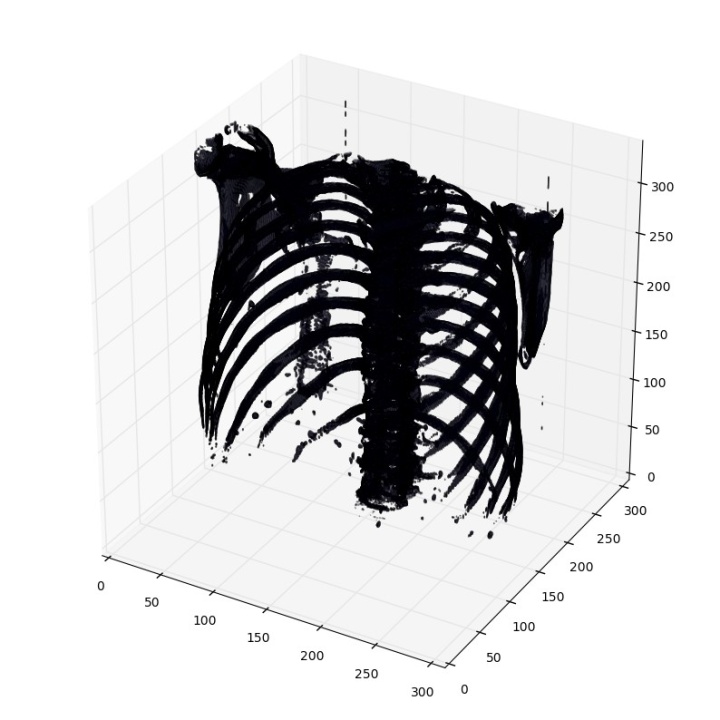
2.6 输出一个病人scans中所有的slices
def plot_ct_scan(scan):
'''
plot a few more images of the slices
:param scan:
:return:
'''
f, plots = plt.subplots(int(scan.shape[0] / 20) + 1, 4, figsize=(50, 50))
for i in range(0, scan.shape[0], 5):
plots[int(i / 20), int((i % 20) / 5)].axis('off')
plots[int(i / 20), int((i % 20) / 5)].imshow(scan[i], cmap=plt.cm.bone)
- 此方法的效果示例如下:
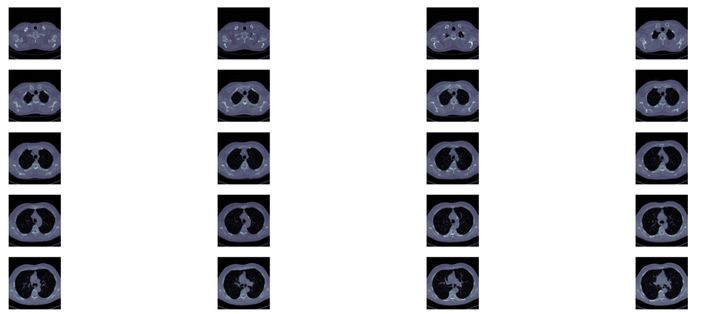
2.7 数据标准化处理
- 归一化处理:
- 当前的值范围是[-1024,2000]。而任意大于400的值并不是处理肺结节需要考虑,因为它们都是不同反射密度下的骨头。LUNA16竞赛中常用来做归一化处理的阈值集是-1000和400.以下代码:
MIN_BOUND = -1000.0
MAX_BOUND = 400.0
def normalize(image):
image = (image - MIN_BOUND) / (MAX_BOUND - MIN_BOUND)
image[image>1] = 1.
image[image<0] = 0.
return image
- 0值中心化:
- 简单来说就是所有像素值减去均值。LUNA16竞赛中的均值大约是0.25.
- 不要对每一张图像做零值中心化(此处像是在kernel中完成的)CT扫描器返回的是校准后的精确HU计量。不会出现普通图像中会出现某些图像低对比度和明亮度的情况
PIXEL_MEAN = 0.25
def zero_center(image):
image = image - PIXEL_MEAN
return image
三 mhd格式数据处理过程
- mhd的数据只是格式与dicom不一样,其实质包含的都是病人的扫描,处理MHD需要借助
SimpleITK这个包,处理思路详情可以参考Data Science Bowl2017的toturail Data Science Bowl 2017.需要注意的是MHD格式的数据没有HU值,它的值域范围与dicom很不同。 - 我们以LUNA2016年的数据处理流程为例。参考代码为: LUNA2016数据切割.
3.1 载入必要的包
import SimpleITK as sitk
import numpy as np
import csv
from glob import glob #用它可以查找符合自己目的的文件
import pandas as pd
# glob方法返回所有匹配的文件路径列表(list);该方法需要一个参数用来指定匹配的路径字符串,
# 其返回的文件名只包括当前目录里的文件名,不包括子文件夹里的文件。
file_list=glob(luna_subset_path+"*.mhd")
#####################
#
# Helper function to get rows in data frame associated
# with each file
def get_filename(case):
# 如果你想要为一个定义在函数外的变量,那么你就得告诉Python这个变量名不是局部的,而是 全局 的。
global file_list
for f in file_list:
if case in f:
return(f)
#
# The locations of the nodes
df_node = pd.read_csv(luna_path+"annotations.csv")
df_node["file"] = df_node["seriesuid"].apply(get_filename) #调用get_filename函数,并函数参数为df_node["seriesuid"]
df_node = df_node.dropna() #将所有含有nan项的row删除
#####
#
# Looping over the image files
#
fcount = 0
for img_file in file_list:
print "Getting mask for image file %s" % img_file.replace(luna_subset_path,"")
mini_df = df_node[df_node["file"]==img_file] #get all nodules associate with file
if len(mini_df)>0: # some files may not have a nodule--skipping those
biggest_node = np.argsort(mini_df["diameter_mm"].values)[-1] # just using the biggest node
node_x = mini_df["coordX"].values[biggest_node]
node_y = mini_df["coordY"].values[biggest_node]
node_z = mini_df["coordZ"].values[biggest_node]
diam = mini_df["diameter_mm"].values[biggest_node]3.2 LUNA16的MHD格式数据的值
- 一直在寻找MHD格式数据的处理方法,对于dicom格式的CT有很多论文根据其HU值域可以轻易地分割肺、骨头、血液等,但是对于MHD没有这样的参考。从LUNA16论坛得到的解释是,LUNA16的MHD数据已经转换为HU值了,不需要再使用slope和intercept来做rescale变换了。此论坛主题下,有人提出MHD格式没有提供pixel spacing(mm) 和 slice thickness(mm) ,而标准文件annotation.csv文件中结节的半径和坐标都是mm单位,最后确认的是MHD格式文件中只保留了体素尺寸以及坐标原点位置,没有保存slice thickness。即,dicom才是原始数据格式。
3.4 坐标体系变换
- MHD值的坐标体系是体素,以mm为单位(dicom的值是GV灰度值)。结节的位置是CT scanner坐标轴里面相对原点的mm值,需要将其转换到真实坐标轴位置,可以使用SimpleITK包中的
GetOrigin()GetSpacing()。图像数据是以512x512数组的形式给出的。 - 坐标体系变换如下:
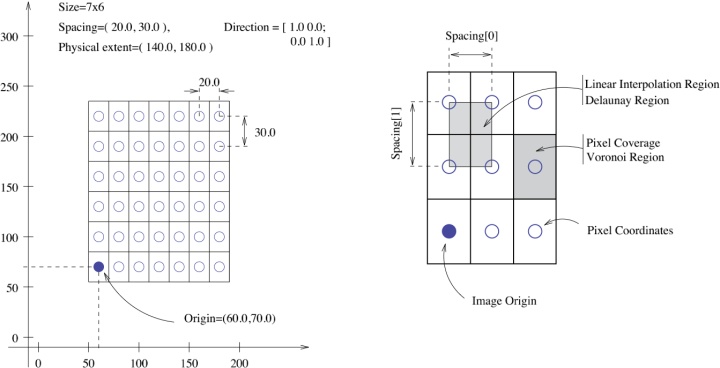
相应的代码处理如下:
itk_img = sitk.ReadImage(img_file)
img_array = sitk.GetArrayFromImage(itk_img) # indexes are z,y,x (notice the ordering)
center = np.array([node_x,node_y,node_z]) # nodule center
origin = np.array(itk_img.GetOrigin()) # x,y,z Origin in world coordinates (mm)
spacing = np.array(itk_img.GetSpacing()) # spacing of voxels in world coor. (mm)
# np.rint(a) 各元素四舍五入
v_center = np.rint((center-origin)/spacing) # nodule center in voxel space (still x,y,z ordering)在LUNA16的标注CSV文件中标注了结节中心的X,Y,Z轴坐标,但是实际取值的时候取的是Z轴最后三层的数组(img_array)。
下述代码只提取了包含结节的最后三个slice的数据,代码参考自
LUNA_mask_extraction.py
i = 0
for i_z in range(int(v_center[2])-1,int(v_center[2])+2):
mask = make_mask(center,diam,i_z*spacing[2]+origin[2],width,height,spacing,origin)
masks[i] = mask
imgs[i] = matrix2int16(img_array[i_z])
i+=1
np.save(output_path+"images_%d.npy" % (fcount) ,imgs)
np.save(output_path+"masks_%d.npy" % (fcount) ,masks)
3.5 查看节点
- 以下代码用于查看原始CT和结节mask。其实就是用matplotlib打印上一步存储的npy文件。
import matplotlib.pyplot as plt
imgs = np.load(output_path+'images_0.npy')
masks = np.load(output_path+'masks_0.npy')
for i in range(len(imgs)):
print "image %d" % i
fig,ax = plt.subplots(2,2,figsize=[8,8])
ax[0,0].imshow(imgs[i],cmap='gray')
ax[0,1].imshow(masks[i],cmap='gray')
ax[1,0].imshow(imgs[i]*masks[i],cmap='gray')
plt.show()
raw_input("hit enter to cont : ") - 接下来的处理和DICOM格式数据差不多,腐蚀膨胀、连通区域标记等。
参考信息
灰度值是pixel value经过重重LUT转换得到的用来进行显示的值,而这个转换过程是不可逆的,也就是说,灰度值无法转换为ct值。只能根据窗宽窗位得到一个大概的范围。 pixel value经过modality lut得到Hu,但是怀疑pixelvalue的读取出了问题。dicom文件中存在(0028,0106)(0028,0107)两个tag,分别是最大最小pixel value,可以用来检验你读取的pixel value 矩阵是否正确。
LUT全称look up table,实际上就是一张像素灰度值的映射表,它将实际采样到的像素灰度值经过一定的变换如阈值、反转、二值化、对比度调整、线性变换等,变成了另外一 个与之对应的灰度值,这样可以起到突出图像的有用信息,增强图像的光对比度的作用。

